Effects of Infrastructure on Land Use and Land Cover Change (LUCC): The Case of Hangzhou International Airport, China
Abstract
:1. Introduction
2. Study Area and Data
2.1. Airport Overview and Study Area
2.2. Data Sources
3. Methodology
3.1. Land Use and Land Cover Interpretation
3.2. Counterfactual Analysis and the Cellular Automata (CA)–Markov Model
3.2.1. Counterfactual Analysis
3.2.2. CA–Markov Model
3.2.3. Simulation Accuracy Verification
4. Results
4.1. Interpreted and Simulated Land Use and Land Cover Maps
4.2. Comparison before and after HIA Construction (Traditional Method of Evaluation)
4.3. Comparison between Interpretation and Simulation in 2001 (Simulation Method of Evaluation)
4.4. Variance of the Two Different Methods of Evaluation
5. Discussion
5.1. Explanation of the Land Use Change after Airport Construction
5.2. Explanations for Why Airport Construction Decelerates the Decrease in Cultivated Land and the Increase in Constructed Land
5.2.1. Limitation of the Airport Clearance Area
5.2.2. Impacts of Aviation Noise or Pollution
5.2.3. Restriction of the Land Use and Land Management System in China
5.2.4. The Shadow of the Future
5.3. Limitations and Possible Improvements in the Future
5.3.1. Other Ignored Factors
5.3.2. Exclusive Focus on Short-Term and Small-Scale Effects
5.3.3. Limitation of the CA–Markov Model
6. Conclusions
Author Contributions
Acknowledgments
Conflicts of Interest
References
- National Development and Reform Commission, Ministry of Foreign Affairs, Ministry of Commerce. To Promote the Construction of the Silk Road Economic zone and the 21st Century Maritime Silk Road Vision and Action. Available online: http://www.mofcom.gov.cn/article/resume/n/201504/20150400929655.shtml (accessed on 2 April 2018). (In Chinese)
- Kumatani, K.; Takahashi, E.; Kato, T. Current and future infrastructure networks aimed at resolving issues related to the changing and diversifying activities in society. Fujitsu Sci. Tech. J. 2013, 49, 271–279. [Google Scholar]
- Hensher, D.A.; Truong, T.P.; Mulley, C.; Ellison, R. Assessing the wider economy impacts of transport infrastructure investment with an illustrative application to the North-West Rail Link project in Sydney, Australia. J. Transp. Geogr. 2012, 24, 292–305. [Google Scholar] [CrossRef]
- Beyzatlar, M.A.; Tepeli, M.Y.I.K. Infrastructure, economic growth and population density in Turkey. Int. J. Econ. Sci. Appl. Res. 2011, 4, 39–57. [Google Scholar]
- Bougheas, S.; Demetriades, P.O.; Mamuneas, T.P. Infrastructure, specialization, and economic growth. J. Econ. Rev. Can. D Econ. 2000, 33, 506–522. [Google Scholar] [CrossRef] [Green Version]
- Easterly, W.; Rebelo, S. Fiscal policy and economic growth. J. Monet. Econ. 1993, 32, 417–458. [Google Scholar] [CrossRef] [Green Version]
- Sanchez Robles, B. Infrastructure investment and growth: Some empirical evidence. Contemp. Econ. Policy 1998, 16, 98–108. [Google Scholar] [CrossRef]
- Canning, D.; Pedroni, P. Infrastructure, long-run economic growth and causality tests for cointegrated panels. Manch. Sch. 2008, 76, 504–527. [Google Scholar] [CrossRef]
- Demetriades, P.O.; Mamuneas, T.P. Intertemporal output and employment effects of public infrastructure capital: Evidence from 12 OECD economies. Econ. J. 2000, 110, 687–712. [Google Scholar] [CrossRef]
- Calderón, C.; Moral Benito, E.; Servén, L. Is infrastructure capital productive? A dynamic heterogeneous approach. J. Appl. Econom. 2015, 30, 177–198. [Google Scholar] [CrossRef]
- Calderón, C.; Servén, L. The Effects of Infrastructure Development on Growth and Income Distribution; World Bank Publications: Washington, DC, USA, 2004. [Google Scholar]
- Venables, A.J. Evaluating urban transport improvements: Cost–benefit analysis in the presence of agglomeration and income taxation. J. Transp. Econ. Policy (JTEP) 2007, 41, 173–188. [Google Scholar]
- Wu, J.; Huang, J.; Han, X.; Xie, Z.; Gao, X. Three-Gorges Dam—Experiment in habitat fragmentation? Science 2003, 300, 1239–1240. [Google Scholar] [CrossRef] [PubMed]
- Forman, R.T.T.; Sperling, D.; Bissonette, J.A.; Clevenger, A.P.; Cutshall, C.D.; Dale, V.H.; Fahrig, L.; France, R.; Goldman, C.R.; Heanue, K. Road Ecology: Science & Solutions; Island Press: Washington, DC, USA, 2003. [Google Scholar]
- Colchero, F.; Conde, D.A.; Manterola, C.; Chávez, C.; Rivera, A.; Ceballos, G. Jaguars on the move: Modeling movement to mitigate fragmentation from road expansion in the Mayan Forest. Anim. Conserv. 2011, 14, 158–166. [Google Scholar] [CrossRef]
- Topalovic, P.; Carter, J.; Topalovic, M.; Krantzberg, G. Light rail transit in Hamilton: Health, environmental and economic impact analysis. Soc. Indic. Res. 2012, 108, 329–350. [Google Scholar] [CrossRef]
- Yigitcanlar, T.; Dur, F. Developing a sustainability assessment model: The sustainable infrastructure, land-use, environment and transport model. Sustainability 2010, 2, 321–340. [Google Scholar] [CrossRef] [Green Version]
- Forman, R.T.T.; Alexander, L.E. Roads and their major ecological effects. Annu. Rev. Ecol. Syst. 1998, 29, 207–231. [Google Scholar] [CrossRef]
- Nemerow, N.L.; Agardy, F.J.; Sullivan, P.; Salvato, J.A. Environmental Engineering: Environmental Health and Safety for Municipal Infrastructure, Land Use and Planning, and Industry; Wiley: Hoboken, NJ, USA, 2009. [Google Scholar]
- Lambin, E.F.; Meyfroidt, P. Global land use change, economic globalization, and the looming land scarcity. Proc. Natl. Acad. Sci. USA 2011, 108, 3465–3472. [Google Scholar] [CrossRef] [PubMed] [Green Version]
- Giuliano, G. Land Use Impacts of Transportation Investments: Highway and Transit; Guilford Press: New York, NY, USA, 2004. [Google Scholar]
- Kasraian, D.; Maat, K.; Stead, D.; van Wee, B. Long-term impacts of transport infrastructure networks on land-use change: An international review of empirical studies. Transp. Rev. 2016, 36, 772–792. [Google Scholar] [CrossRef]
- Mojica, L.; Martí-Henneberg, J. Railways and Population Distribution: France, Spain, and Portugal, 1870–2000. J. Interdiscip. Hist. 2011, 42, 15–28. [Google Scholar] [CrossRef]
- Zhang, Y.; Yan, J.; Liu, L.; Bai, W.; Zheng, D. Effects of Qinghai-Xizang Highway on land use and landscape pattern change: From Golmud to Tanggulashan pass. Acta Geogr. Sin. 2002, 57, 253–266. (In Chinese) [Google Scholar]
- Swangjang, K.; Iamaram, V. Change of land use patterns in the areas close to the airport development area and some implicating factors. Sustainability 2011, 3, 1517–1530. [Google Scholar] [CrossRef]
- Ferreira, L.; Stevens, N.J.; Baker, D.C. The New Airport and its Urban Region: Evaluating Transport Linkages. Airport Strategic Planning. In Proceedings of the International Conference on Traffic and Transport Studies, Xi’an, China, 2–5 August 2006; pp. 22–29. [Google Scholar]
- Karsner, D. Aviation and airports: The impact on the economic and geographic structure of American cities, 1940s–1980s. J. Urban Hist. 1997, 23, 406–436. [Google Scholar] [CrossRef]
- Civil Aviation Administration of China, National Development and Reform Commission, Ministry of Transport. China’s Civil Aviation Development of the Thirteenth Five-Year Plan; Civil Aviation Administration of China, National Development and Reform Commission, Ministry of Transport: Beijing, China, 2016. (In Chinese)
- Lu, D.; Mausel, P.; Brondizio, E.; Moran, E. Change detection techniques. Int. J. Remote Sens. 2004, 25, 2365–2407. [Google Scholar] [CrossRef]
- Zhang, J.X.; Zhang, Y.H. Remote sensing research issues of the National Land Use Change Program of China. ISPRS J. Photogramm. Remote Sens. 2007, 62, 461–472. [Google Scholar] [CrossRef]
- Weng, Q.H. Land use change analysis in the Zhujiang Delta of China using satellite remote sensing, GIS and stochastic modelling. J. Environ. Manag. 2002, 64, 273–284. [Google Scholar] [CrossRef] [Green Version]
- Campbell, J.B.; Wynne, R.H. Introduction to Remote Sensing; Guilford Press: New York, NY, USA, 2011. [Google Scholar]
- Liu, J. Study on national resources & environment survey and dynamic monitoring using remote sensing. J. Remote Sens. 1997, 1, 225–230. (In Chinese) [Google Scholar]
- Liu, J.Y.; Liu, M.L.; Zhuang, D.F.; Zhang, Z.X.; Deng, X.Z. Study on spatial pattern of land-use change in China during 1995–2000. Sci. China Ser. D Earth Sci. 2003, 46, 373–384. (In Chinese) [Google Scholar]
- Liu, J.Y.; Kuang, W.H.; Zhang, Z.X.; Xu, X.L.; Qin, Y.W.; Ning, J.; Zhou, W.C.; Zhang, S.W.; Li, R.D.; Yan, C.Z.; et al. Spatiotemporal characteristics, patterns, and causes of land-use changes in China since the late 1980s. J. Geogr. Sci. 2014, 24, 195–210. [Google Scholar] [CrossRef]
- Lillesand, T.M. Remote Sensing and Image Interpretation; Wiley: Hoboken, NJ, USA, 1979; pp. 3035–3038. [Google Scholar]
- Rubin, D.B. Estimating causal effects of treatments in randomized and nonrandomized studies. J. Educ. Psychol. 1974, 66, 688–701. [Google Scholar] [CrossRef]
- Cowan, R.; Foray, D. Evolutionary economics and the counterfactual threat: On the nature and role of counterfactual history as an empirical tool in economics. J. Evol. Econ. 2002, 12, 539–562. [Google Scholar] [CrossRef]
- Keohane, R.O. Counterfactuals and causal inference: Methods and principles for social research. Soc. Forces 2009, 88, 466–467. [Google Scholar] [CrossRef]
- Abadie, A.; Diamond, A.; Hainmueller, J. Synthetic control methods for comparative case studies: Estimating the effect of California’s Tobacco control program. J. Am. Stat. Assoc. 2010, 105, 493–505. [Google Scholar] [CrossRef]
- Muller, M.R.; Middleton, J. A Markov model of land-use change dynamics in the Niagara region, Ontario, Canada. Landsc. Ecol. 1994, 9, 151–157. [Google Scholar]
- Brown, D.G.; Pijanowski, B.C.; Duh, J.D. Modeling the relationships between land use and land cover on private lands in the Upper Midwest, USA. J. Environ. Manag. 2000, 59, 247–263. [Google Scholar] [CrossRef] [Green Version]
- Sang, L.; Zhang, C.; Yang, J.; Zhu, D.; Yun, W. Simulation of land use spatial pattern of towns and villages based on CA–Markov model. Math. Comput. Model. 2011, 54, 938–943. [Google Scholar] [CrossRef]
- Tallis, J.H.; Glenn-Lewin, D.C.; Peet, R.K.; Veblen, T.T. Plant succession: Theory and prediction. J. Ecol. 1993, 81, 830. [Google Scholar] [CrossRef]
- Wickramasuriya, R.C.; Bregt, A.K.; van Delden, H.; Hagen-Zanker, A. The dynamics of shifting cultivation captured in an extended Constrained Cellular Automata land use model. Ecol. Model. 2009, 220, 2302–2309. [Google Scholar] [CrossRef]
- Tattoni, C.; Ciolli, M.; Ferretti, F. The fate of priority areas for conservation in protected areas: A fine-scale Markov chain approach. Environ. Manag. 2011, 47, 263–278. [Google Scholar] [CrossRef] [PubMed]
- Balzter, H.; Braun, P.W.; Kohler, W. Cellular automata models for vegetation dynamics. Ecol. Model. 1998, 107, 113–125. [Google Scholar] [CrossRef] [Green Version]
- Yeh, A.G.O.; Li, X. A cellular automata model to simulate development density for urban planning. Environ. Plan. B Plan. Des. 2002, 29, 431–450. [Google Scholar] [CrossRef]
- Li, H.; Reynolds, J.F. Modeling effects of spatial pattern, drought, and grazing on rates of rangeland degradation: A combined Markov and cellular automaton approach. Scale Remote Sens. GIS 1997, 211–230. [Google Scholar]
- Adhikari, S.; Southworth, J. Simulating forest cover changes of Bannerghatta National Park based on a CA-Markov model: A remote sensing approach. Remote Sens. Basel 2012, 4, 3215–3243. [Google Scholar] [CrossRef]
- Subedi, P.; Subedi, K.; Thapa, B. Application of a hybrid cellular automaton-Markov (CA-Markov) model in land-use change prediction: A case study of Saddle Creek Drainage Basin, Florida. Sci. Educ. 2013, 1, 126–132. [Google Scholar] [CrossRef]
- Wu, F.L. Calibration of stochastic cellular automata: The application to rural-urban land conversions. Int. J. Geogr. Inf. Sci. 2002, 16, 795–818. [Google Scholar] [CrossRef]
- Pontius, R.G.; Cornell, J.D.; Hall, C.A.S. Modeling the spatial pattern of land-use change with GEOMOD2: Application and validation for Costa Rica. Agric. Ecosyst. Environ. 2001, 85, 191–203. [Google Scholar] [CrossRef]
- Wijk, M.V.; Brattinga, K.; Bontje, M.A. Exploit or protect airport regions from urbanization? Assessment of land-use restrictions in Amsterdam-Schiphol. Eur. Plan. Stud. 2011, 19, 261–277. [Google Scholar] [CrossRef]
- Federal Aviation Administration. Airport Design; Advisory Circular 150/5300-13A; Washington, DC, USA, 2012.
- Devault, T.; Kubel, J.; Rhodes, O.; Dolbeer, R. Habitat and bird communities at small airports in the Midwestern USA. In Proceedings of the 13th WDM Conference, Lincoln, NE USA, 2009; University of Nebraska–Lincoln: Lincoln, NE, USA, 2009; Volume 13, pp. 137–145. [Google Scholar]
- Kasarda, J.D. Airport cities: The evolution. Airpt. World 2013, 18, 24–27. [Google Scholar]
- Reiss, B. Maximising non-aviation revenue for airports: Developing airport cities to maximise real estate and capitalise on land development opportunities. J. Airpt. Manag. 2007, 1, 284–293. [Google Scholar]
- Clearance Area of an Airfield. Available online: http://www.planete-tp.com/en/clearance-area-of-an-airfield-a44.html (accessed on 8 January 2017).
- Standing Committee of the People Congress. The Civil Aviation Law of People’ Republic of China; Standing Committee of the People Congress: Beijing, China, 1995. (In Chinese)
- Cidell, J.L. Scales of Airport Expansion: Globalization, Regionalization, and Local land Use; The University of Minnesota Digital Conservancy: Minneapolis, MN, USA, 2004; p. 313. [Google Scholar]
- Collins, A.; Evans, A. Aircraft noise and residential property values: An artificial neural network approach. J. Transp. Econ. Policy 1994, 28, 175–197. [Google Scholar]
- Nelson, P. Meta-analysis of airport noise and hedonic-property values-problems and prospects. J. Transp. Econ. Policy 2004, 38, 1–27. [Google Scholar]
- Uyeno, D.; Hamilton, S.W.; Biggs, A.J.G. Density of Residential Land Use and the Impact of Airport Noise. J. Transp. Econ. Policy 1991, 27, 3–18. [Google Scholar]
- Jud, G.D.; Winkler, D.T. The announcement effect of an airport expansion on housing prices. J. Real Estate Financ. Econ. 2006, 33, 91–103. [Google Scholar] [CrossRef]
- Central Committee of the Communist Party the State Council of China. Circular on Further Strengthening Land Administration and Effectively Protecting Cultivated Land; Central Committee of the Communist Party the State Council of China: Beijing, China, 1997. (In Chinese)
- Xiaoshan City Government. On the Request of the Hangzhou International Airport Construction Project Address in Xiaoshan; Xiaoshan City Government: Hangzhou, China, 1992. (In Chinese)
- Wang, H.; Tao, R.; Wang, L.L.; Su, F.B. Farmland preservation and land development rights trading in Zhejiang, China. Habitat Int. 2010, 34, 454–463. [Google Scholar] [CrossRef]
- Kityuttachai, K.; Tripathi, N.K.; Tipdecho, T.; Shrestha, R. CA-Markov analysis of constrained coastal urban growth modeling: Hua Hin Seaside City, Thailand. Sustainability 2013, 5, 1480–1500. [Google Scholar] [CrossRef]
- Lambin, E.F.; Turner, B.L.; Geist, H.J.; Agbola, S.B.; Angelsen, A.; Bruce, J.W.; Coomes, O.T.; Dirzo, R.; Fischer, G.; Folke, C.; et al. The causes of land-use and land-cover change: Moving beyond the myths. Glob. Environ. Chang. Hum. Policy Dimens. 2001, 11, 261–269. [Google Scholar] [CrossRef]
- Zhou, D.; Lin, Z.; Liu, L. Regional land salinization assessment and simulation through cellular automaton-Markov modeling and spatial pattern analysis. Sci. Total Environ. 2012, 439, 260–274. [Google Scholar] [CrossRef] [PubMed]
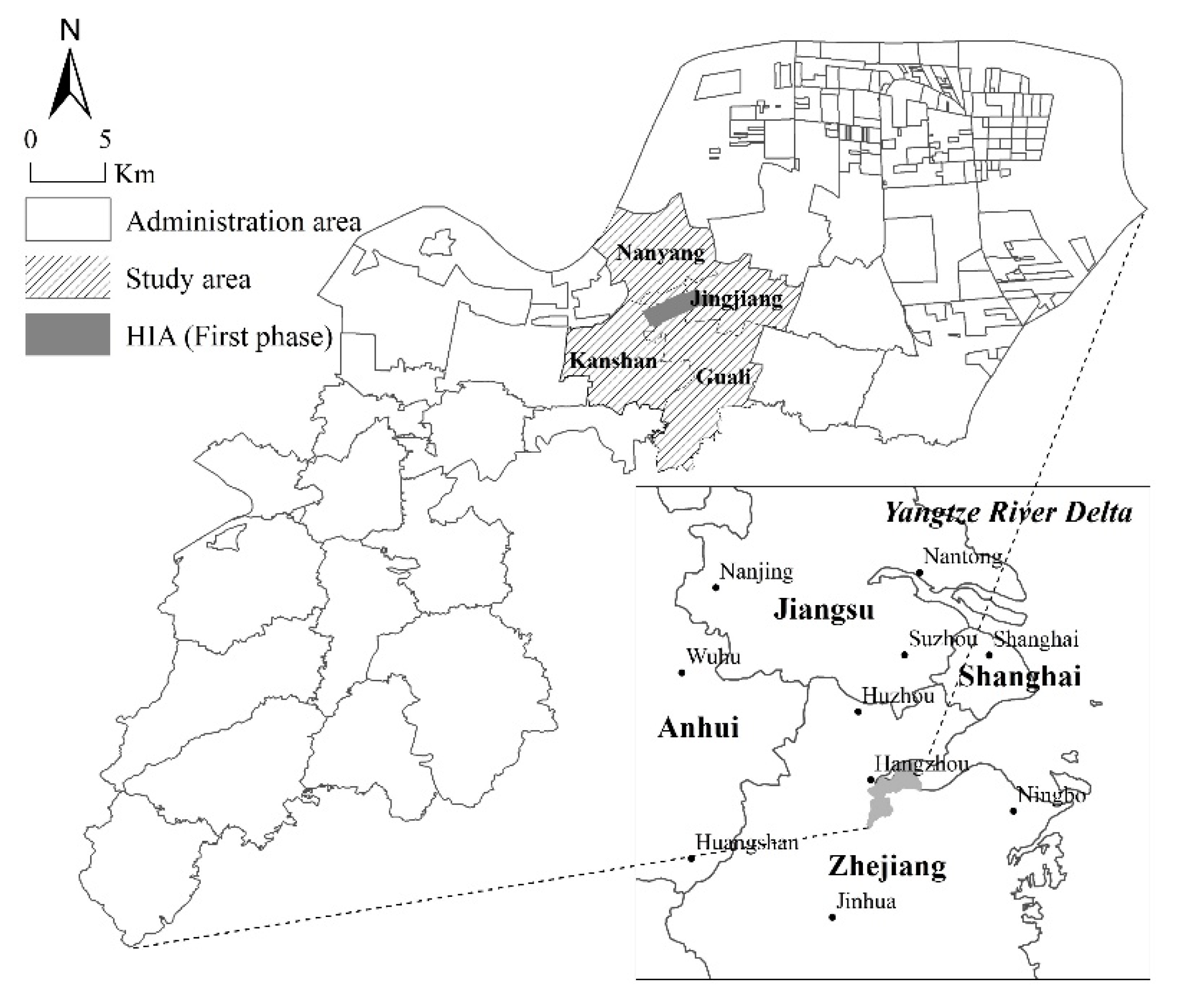
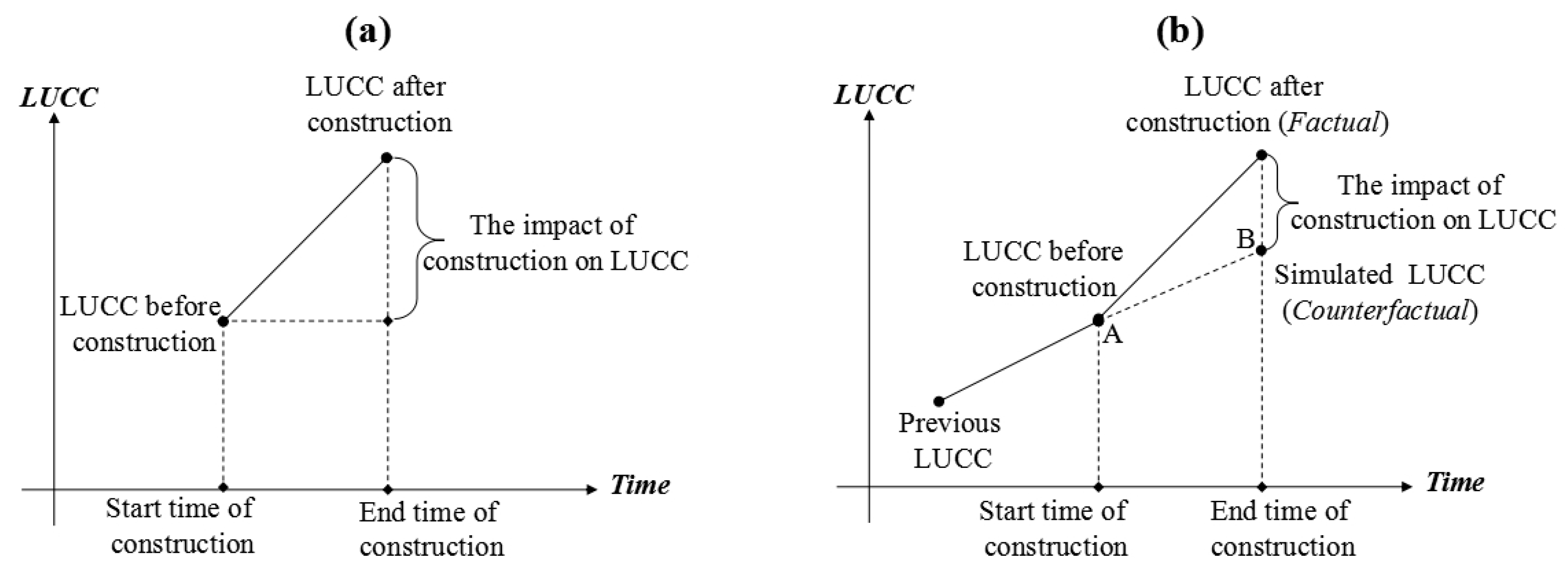

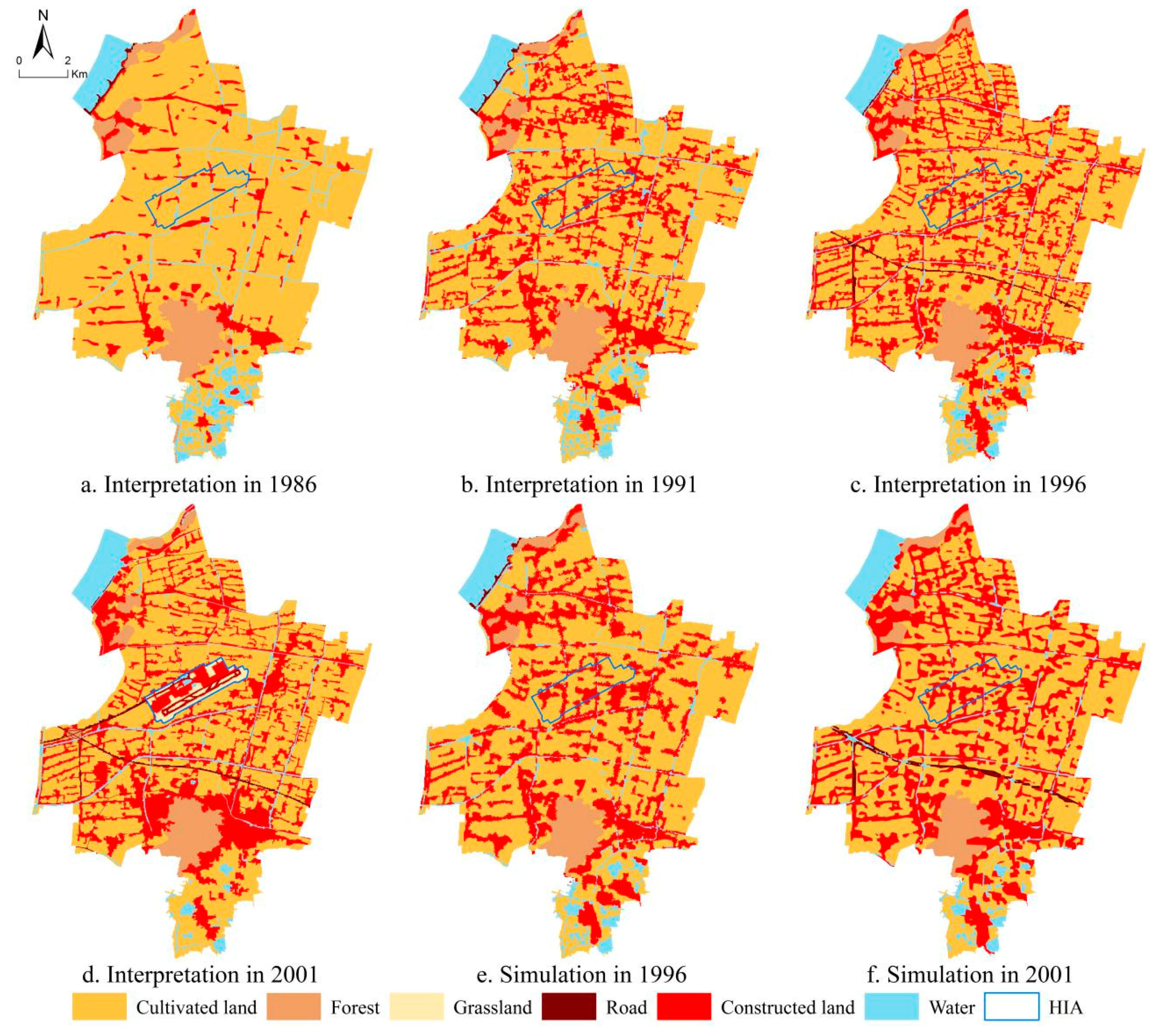
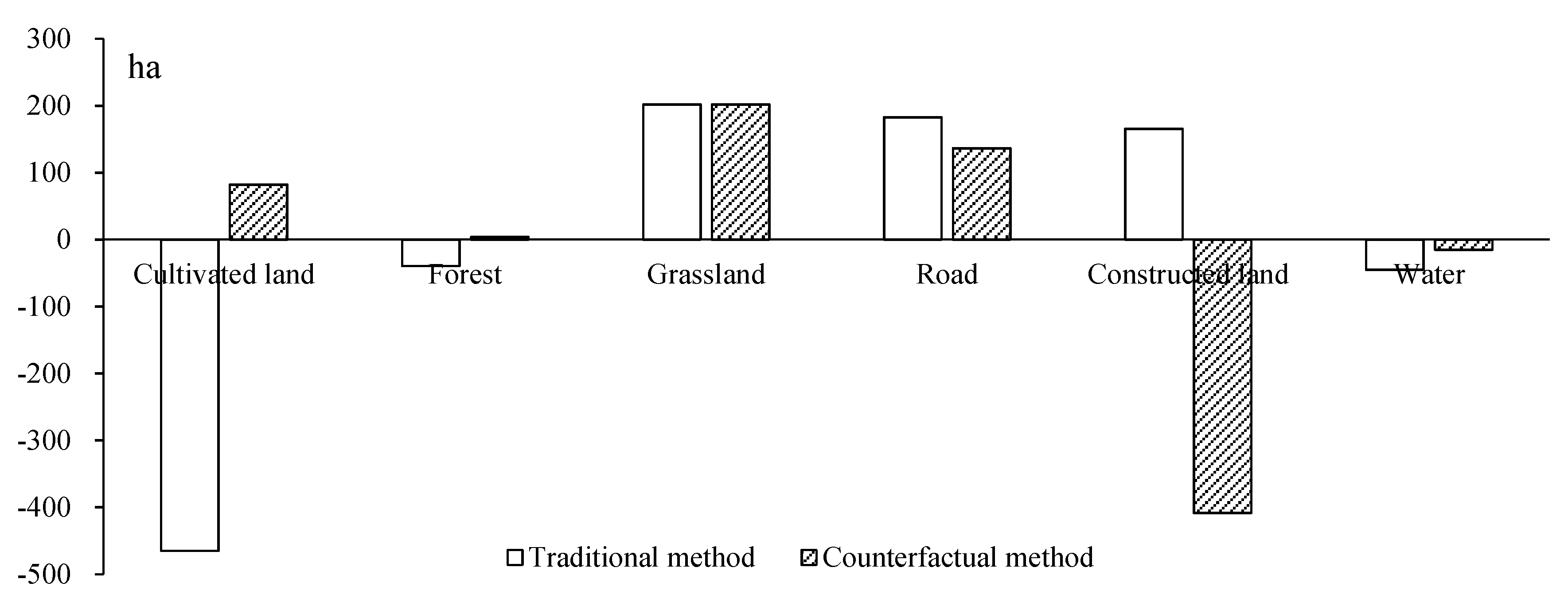
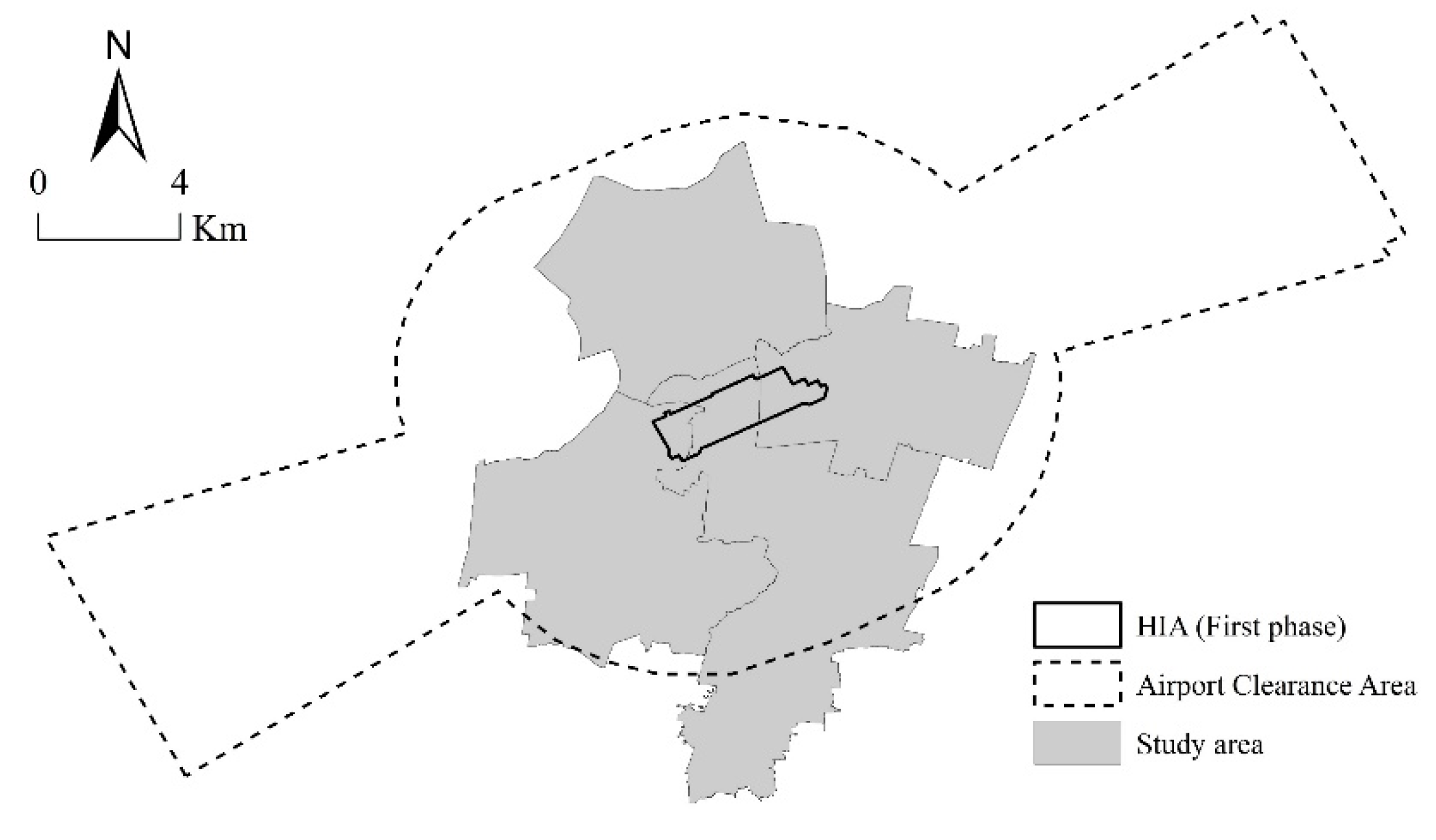
| Class | Description |
|---|---|
| Cultivated land | Refers to areas cultivated with annual crops, vegetables, or fruit, including newly reclaimed land, paddies, and dry land |
| Forest | Refers to forestry lands, including timber, fuel wood, shelter and economic forests, sparse woodlands, and shrubs |
| Grassland | Refers to land for growing herbs; it mainly includes planted grassland along with the construction of the airport runway |
| Road | Refers to infrastructure land for vehicles and pedestrians, mainly including highways and the airport runway |
| Constructed land | Refers to land for construction activities, including urban and rural residences, industry, mining, salt panning, and specially used land (excluding roads) |
| Water | Refers to land covered by a certain area of water, including rivers, lakes, reservoirs, beaches, canals, and breeding plots |
| 1996 | Cultivated Land | Forest | Road | Constructed Land | Water |
|---|---|---|---|---|---|
| Interpretation | 7810.09 | 761.15 | 100.22 | 3568.01 | 939.46 |
| Simulation | 7774.39 | 728.83 | 28.20 | 3660.83 | 986.68 |
| Area change a | −35.70 | −32.32 | −72.02 | 92.82 | 47.22 |
| 1996 | Cultivated Land | Forest | Grassland | Road | Constructed Land | Water | Total | |
|---|---|---|---|---|---|---|---|---|
| 2001 | ||||||||
| Cultivated land | 5858.03 | 44.03 | 136.33 | 148.02 | 1535.65 | 88.03 | 7810.09 | |
| Forest | 68.19 | 616.93 | 0.00 | 0.00 | 69.02 | 7.01 | 761.15 | |
| Grassland | 0.00 | 0.00 | 0.00 | 0.00 | 0.00 | 0.00 | 0.00 | |
| Road | 15.54 | 2.46 | 0.00 | 59.28 | 8.86 | 14.08 | 100.22 | |
| Constructed land | 1215.42 | 57.83 | 61.96 | 58.52 | 2023.58 | 150.70 | 3568.01 | |
| Water | 187.69 | 0.38 | 3.41 | 17.02 | 96.37 | 634.59 | 939.46 | |
| Total | 7344.88 | 721.64 | 201.70 | 282.83 | 3733.47 | 894.41 | 13,178.93 | |
| Area change a | −465.21 | −39.51 | 201.70 | 182.61 | 165.46 | −45.05 | 0.00 | |
| Land Use Type | 1996 | 2001 | Area Change a | ||
|---|---|---|---|---|---|
| Area | Percentage | Area | Percentage | ||
| Cultivated land | 324.20 | 68.79% | 0.00 | 0.00% | −324.1 |
| Grassland | 0.00 | 0.00% | 201.71 | 42.80% | 201.71 |
| Road | 0.00 | 0.00% | 85.30 | 18.10% | 85.30 |
| Constructed land | 141.01 | 29.92% | 169.97 | 36.06% | 28.96 |
| Water | 6.10 | 1.29% | 14.34 | 3.04% | 8.24 |
| Total of HIA | 471.31 | 100.00% | 471.31 | 100.00% | 0.00 |
| Land Use Type | Simulation without HIA Construction in 2001 | Interpretation after HIA Construction in 2001 | Area Variance a | Percentage Variance b | ||
|---|---|---|---|---|---|---|
| Area | Percentage | Area | Percentage | |||
| Cultivated land | 7262.81 | 55.17% | 7344.88 | 55.73% | 82.07 | 0.56% |
| Forest | 717.77 | 5.45% | 721.64 | 5.48% | 3.87 | 0.03% |
| Grassland | 0.00 | 0.00% | 201.70 | 1.53% | 201.70 | 1.53% |
| Road | 146.41 | 1.11% | 282.83 | 2.15% | 136.42 | 1.04% |
| Constructed land | 4142.16 | 31.36% | 3733.47 | 28.33% | −408.69 | −3.03% |
| Water | 909.79 | 6.91% | 894.41 | 6.79% | −15.38 | −0.12% |
| Total | 13,178.93 | 100.00% | 13,178.93 | 100.00% | 0.00 | 0.00% |
© 2018 by the authors. Licensee MDPI, Basel, Switzerland. This article is an open access article distributed under the terms and conditions of the Creative Commons Attribution (CC BY) license (http://creativecommons.org/licenses/by/4.0/).
Share and Cite
Xiong, C.; Beckmann, V.; Tan, R. Effects of Infrastructure on Land Use and Land Cover Change (LUCC): The Case of Hangzhou International Airport, China. Sustainability 2018, 10, 2013. https://doi.org/10.3390/su10062013
Xiong C, Beckmann V, Tan R. Effects of Infrastructure on Land Use and Land Cover Change (LUCC): The Case of Hangzhou International Airport, China. Sustainability. 2018; 10(6):2013. https://doi.org/10.3390/su10062013
Chicago/Turabian StyleXiong, Changsheng, Volker Beckmann, and Rong Tan. 2018. "Effects of Infrastructure on Land Use and Land Cover Change (LUCC): The Case of Hangzhou International Airport, China" Sustainability 10, no. 6: 2013. https://doi.org/10.3390/su10062013





